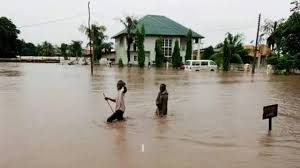Following a heavy overnight downpour that lasted from late Monday into the early hours of Tuesday, several communities within the Kuje Area Council of the Federal Capital Territory are grappling with widespread destruction to homes, businesses, and farmlands.
As first reported by Abuja Metro, the rainstorm — marked by intense winds and flash flooding — tore through residential areas, rustic open-air restaurants, and makeshift bamboo structures commonly used as local gathering spots. Entire farmlands were submerged, compounding the hardship faced by smallholder farmers who rely heavily on seasonal crops for sustenance and income.
In hard-hit areas such as Gudaba, Kuchiyakwo, and Pegi, residents are counting their losses. Structures built from thatch and bamboo were reduced to rubble, while agricultural lands cultivated with maize, cassava, yams, and vegetables were washed away.
Mr. Hassan, a local farmer affected by the flood, described the situation as devastating. “My first corn field was completely destroyed on Monday, and by Tuesday morning, the remaining plot had been submerged. It’s really frustrating as I am strongly dependent on that farmland for produce,” he said.
The disaster aligns with earlier warnings issued by the Nigerian Meteorological Agency (NiMet), which in its 2025 Seasonal Climate Prediction had projected above-average rainfall across the North Central zone, including the Federal Capital Territory. The agency had cautioned that such rainfall patterns could result in localized flooding, particularly in areas with inadequate drainage systems and unregulated urban development.
With farmlands lost and many informal businesses washed away, the aftermath of the storm leaves urgent questions about climate resilience, urban planning, and the preparedness of rural communities in the FCT to face extreme weather events.




